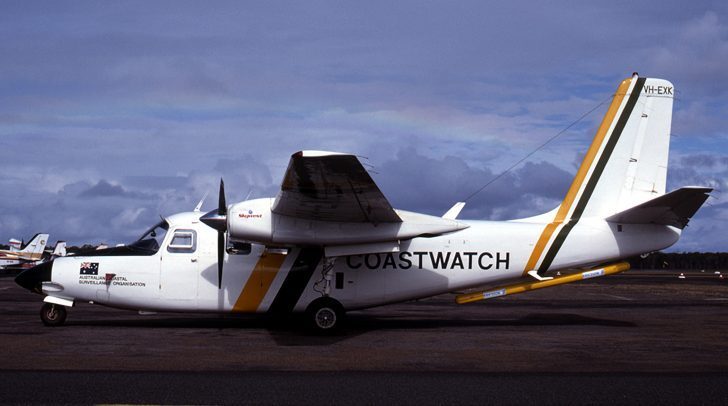By Barry Collman

VH-EXK: Scanned from a slide taken in 1984 by Peter Keating at Bundaberg, a city on Australia’s Queensland coast, VH-EXK is serial number 1715-26. It is one of many Commanders that have been operated in Australia over the years, and one of quite a number operated for the Australian Coastal Surveillance Organization Coastwatch by a few different companies. It was originally certificated as N4566E in May 1967, with a forward cabin door installed. It soon became N218M, before export to Australia in December 1972. Note the “Miller” nose, installed in November 1982, and the Ericsson SLAR under rear fuselage, installed in September 1984. It was withdrawn from use in June 1990.
The 500U was the fifteenth Commander model to be placed into production. In all 55 were produced, the first 12 by the Aero Commander Division of Rockwell-Standard Corporation at Bethany (Wiley Post Airport), Oklahoma City, Oklahoma; the next 21 by the Aero Commander-Bethany Division of Rockwell-Standard Corporation; and the last 22 by the Aero Commander Division of North American Rockwell Corporation.
The 55 examples were built between March 1966 and May 1968, with serial numbers in the range 1635-1 through 1780-55.
Of these, 19 were certified in 1966; 12 in 1967; and 24 in 1968.
A factory document describes the Model 500U, under Wing Drawing 5170045 modified for 8500lb. wing, as “certified as a utility category airplane on December 11, 1964. Except for the Utility Category, the only difference from the 500B was installation of the ‘8500 lb’ wing.”
The Model 500U was initially certified on December 11, 1964, under Type Certificate 6A1. The first 14 airplanes had the 290 hp Lycoming IO-540-E1A5 engines, while the last 41 had the IO-540-E1B5. The first 37 500Us produced had 80.625-inch-diameter Hartzell HC-A3VK-2A/V8433-4 propellers, with the remaining 18 using the V8433A-4 variant blades, which have a 1 degree sweepback instead of the usual 2 degrees.
Gross Weight is 6,750 lbs.
No doubt the “U” suffix reflects that the 500U was certified in both Normal and Utility categories.
One strange anomaly is that the 1964 certification date is approximately 15 months earlier than when the first 500U had its initial Certificate of Airworthiness issued—March 26, 1966. The reason is that a Model 500B was used for certification purposes. The 500U originated as technically a “paper airplane” that was proposed to the U.S. Army in response to a Request For Proposal (RFP) issued for a particular training aircraft. This was easily done by proposing the installation of Model 680FL wing structure onto the Model 500B airframe. No additional testing was involved, only submission of structural analysis reports to the FAA. As noted earlier, the Model 500U was later described by the FAA as follows: “Except for the utility category, the only difference from the 500B was the installation of the ‘8500 lb’ wing.”
The Factory Drawing Section Lists contain modification type drawings for installing both an aileron trim tab system as well as adjustable rudder pedals, both being listed as applicable to the Model 500B only. From the dates listed, drawings for these modifications would have been completed in November 1964, hence they would not have been installed on 500B serial number 1162-85, which was demonstrated to the U.S. Army in October 1964. It is possible that the factory completed the engineering designs to show compliance with the RFP requirements, but never installed the modifications on an actual aircraft. Neither of these two features was made available on the 500U production aircraft that followed.
In 1968, the Model 500U was given the “Shrike” name, with 14 airplanes delivered to the Fuerza Aerea Argentina.

XB-NAU: Scanned from a slide taken on June 12, 1976 at Guadalajara, Jalisco, Mexico, by an unknown photographer, XB-NAU is serial number 1668-17 and was exported as a new aircraft in February 1967 for Cementos Mexicanos SAdeCV. of Monterrey, Nuevo Leon. At the time the slide was taken it was owned by Belloc Carlos Zambrano, of Guadalajara. It has been subsequently re-registered in Mexico, first as XA-TMW in January 1999, then as XB-KSK in April 2008. It is still current there.
Visually, the 500U is the same as the late-build Model 500B, having the ‘flush’ skinning of the control surfaces, and the early-build examples of the Model 500S that followed.
Barry Collman’s lifelong interest in airplanes began when he was growing up in a house located underneath the downwind leg to busy Northolt aerodrome, an R.A.F. base near London-Heathrow airport. As a young teenager he discovered airplane “spotting”–hobbyists’ observation and logging of aircraft by make, model, and registration number. The hobby began to grow into a passion as Collman joined a club of like-minded spotters. At one point he purchased a copy of the January 1966 U.S. Civil Aircraft Register, and thumbing through it came upon the Aero Commander. He was hooked. Eventually he acquired every available FAA microfiche file on Commanders, and since 1995 has made annual pilgrimages to Oklahoma City to sift through FAA records. He now has a database with more than 96,100 records as well as a collection of negatives, slides, photographs, digital images, magazines, brochures, knick-knacks–and a very understanding wife. This series on Commander production history originally was written for the Twin Commander Flight Group, of which he is an enthusiastic member.
